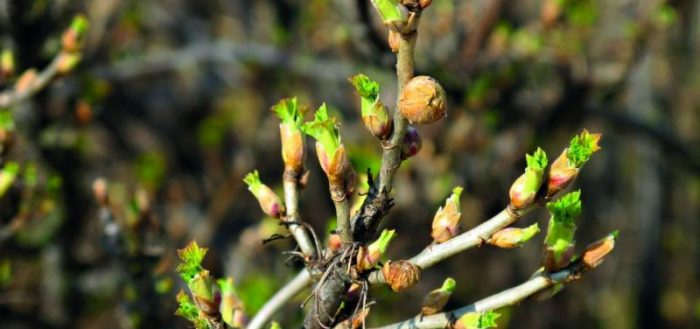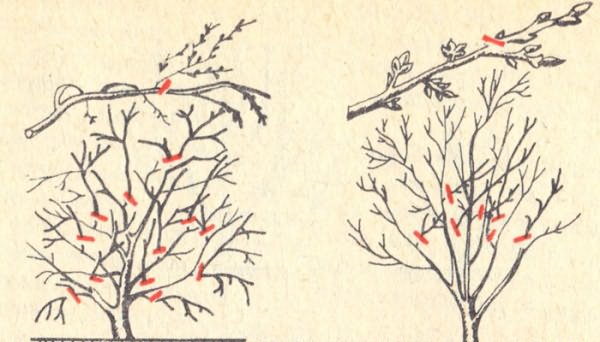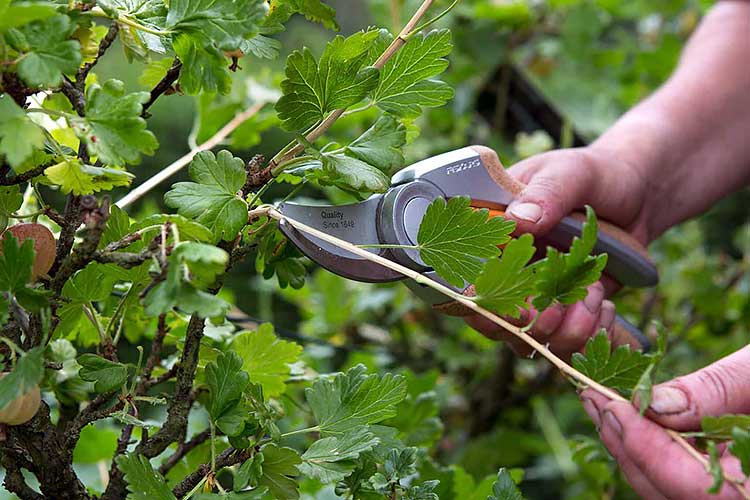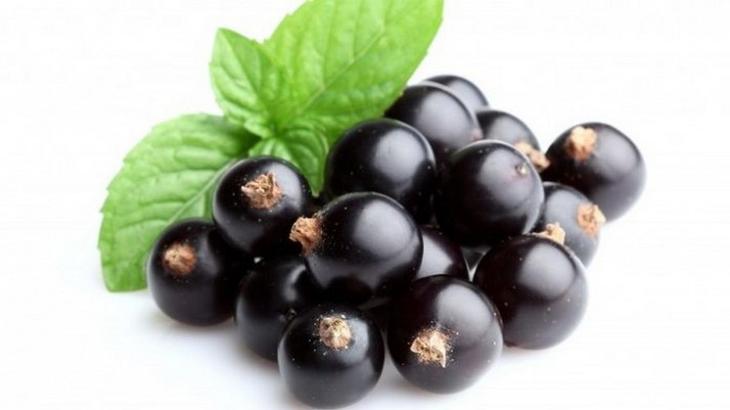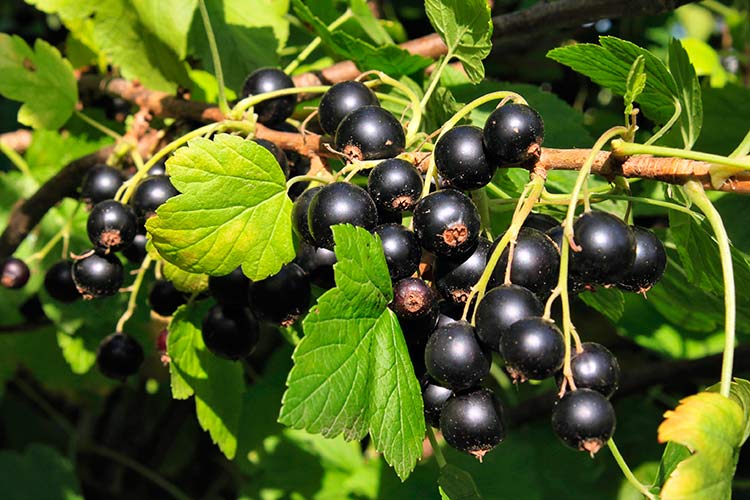Content:
Black currant is considered to be an unpretentious horticultural crop that does not require complex care. However, the need for basic measures to keep the shrub in a healthy state still exists. One of these is pruning black currants in the spring. In addition, molding the black currant helps to prolong the ability of the shrub to bear fruit. It should be noted that gooseberries are also processed using a similar technology.
Why spring pruning is needed
Pruning blackcurrants during springtime has the following benefits:
- Removing broken or deformed branches, which could be damaged by gusty wind or mechanical stress, will help prevent them from absorbing useful minerals, which will allow the plant to acquire new growth, healthy and capable of bearing fruit;
- Cutting off old branches that did not bring a high-quality harvest of berries last season or did not bear fruit at all will allow the plant to replace old branches with new young shoots;
- The cut off part of the bush will contribute to a more abundant flow of sunlight to the fruits, which is why the berry that begins to ripen acquires a pronounced reddish tint and a peculiar taste;
- Removing frozen branches that are unable to release foliage and form berry fruits will stop the distribution of nutrients to dead shoots, aimed at restoring branches unsuitable for fruiting;
- Spring sanitary pruning will allow you to prune branches affected by parasitic insects and fungal diseases that are activated during this time of year.
How to do spring pruning
When pruning a blackcurrant bush, five-year-old branches must be removed.
The step-by-step scheme for pruning black currants in spring is as follows:
- Clear the area near the shrub from last year's foliage;
- Examine each branch of the bush;
- Remove dry branches;
- Get rid of broken shoots;
- Cut off frozen branches;
- Cut the shoots towards the center;
- Remove overgrowth with dried out ends;
- Cut the apical part of the annual shoots;
When pruning over green buds, leave a good 5mm piece of the shoot to prevent it from drying out and provide the necessary nutrients, while pruning at a higher point will lead to wilting and death of the developing branch.
When cutting, you should try to visually adhere to the 45th angle measure and observe the direction from the central part outward - this will avoid thickening, will contribute to a more abundant supply of sunlight to the bud, and will have a positive effect on the yield and size of berries in general.
- Cut off the "tops" branches;
- Remove old branches lacking green shoots;
- Healthy growth is also shortened by ⅓ part.
If there is insufficient visual representation of the cropping procedure, you can turn to the search for visual images presented on the network. Each schematic picture clearly shows which specific parts of the shoots need to be shortened.
How to prune a neglected shrub
First of all, before you start to form a neglected currant bush, you should start thinning the crown part. To do this, such deformed branches are removed from the shrub as:
- damaged;
- drooping;
- not fully developed;
- unable to bear fruit;
- directed inside the bush.
After further inspection of the plant, 3 shoots should be left, which are one year old, and the remaining branches should be pruned.
The dried ends of the shoots on old shrubs are cut off before moving to the first branch.
Carrying out subsequent pruning activities depends on the yield of specific branches.
Features of pruning black currant
The main feature is the difference in ways of how to carry out the correct set of pruning procedures for bushes of different ages. Primary pruning of shoots is carried out immediately after planting, provided that 3 buds are preserved on each branch.
In the next season, pruning is to improve the condition of the shoots of the current year. The formation of skeletal branches comes from last year's growth. After pruning, 5 healthy branches should remain on the bush, while the rest of the green growth must be removed.
The bush should be formed in the same way in the next two years. Last year's shoots are used to form skeletal branches, and 5 green shoots are selected from the young shoots, all the rest are removed.
Formation should be stopped when the shrub reaches five years of age. However, every season it is necessary to remove branches that are more than two years old, due to their inability to bear fruit and consume nutrients. In addition, all branches that contribute to excessive thickening of the crown and germinate close to the soil surface are cut off.
Rejuvenation of the black currant bush
Step-by-step instructions for rejuvenating an old black currant bush by correctly molding:
- The thickened part of the shrub must be thinned out;
- Remove branches whose growth is directed towards the inside of the bush;
- Get rid of thin stems;
- Cut off weakened shoots;
- Remove broken branches;
- It is necessary to cut off the growth that is incapable of fruiting;
- Leave 3 healthy annual shoots;
- Cut off the dried apical part of the old stems.
How to properly process a slice
To gloss over the cuts after trimming, a garden pitch is used. Such treatment minimizes the loss of sap, and also prevents the penetration of parasitic insects and bacterial foci into the stem of the plant.
You can buy a garden pitch at a specialized outlet or start making it at home from the following components:
- rosin wax;
- turpentine liquid;
- melted unsalted pork fat.
To make a home garden var, there is a step-by-step procedure:
- Turn on a small fire;
- Melt the wax;
- Add all ingredients to the wax;
- Stir the essence periodically;
- Cook until smooth;
- Pour the var into a container;
- Leave the mixture to dry;
- Wait for the home preparation to harden completely.
General care measures
The mode of irrigation depends on a number of factors, however, it is especially necessary to water the black currant bush abundantly during the transition to the active stage of the growth of young shoots, the formation of ovaries, during the fruiting period and after the completion of harvesting. In addition, careful watering is necessary for plantings in hot summer weather and subject to germination in dry hot regions where precipitation is rare.
With the onset of the spring season in the second year after planting in a permanent place, weakened and incompletely developed branches should be removed. In the third year, surplus shoots are cut off, after pruning, 5 healthy shoots should remain. In subsequent seasons, pruning is carried out for sanitary and rejuvenating purposes. It is necessary to complete the trimming work before the buds open. Trim small shoots as well as dried, deformed and secondary shoots.
Carrying out spring pruning of black currant bushes will positively affect the quality indicator of crop yield, and also prevent the emergence of pathogenic foci and larvae of parasitic insects. The only condition for proper pruning is a competent approach and careful observance of all agrotechnical recommendations.
